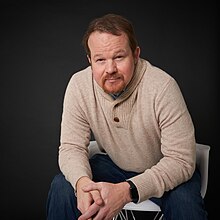Waitman Wade Beorn is an American historian and former US cavalry officer who specializes in Holocaust studies, focusing on the Holocaust in Eastern Europe. He is currently an Assistant Professor in History at Northumbria University in Newcastle upon Tyne.[1][2] Beorn previously served as the Louis and Frances Blumkin Professor of Holocaust and Genocide Studies at the University of Nebraska Omaha. From 2015 to 2016, he was the executive director of the Virginia Holocaust Museum in Richmond, Virginia.

Early life
editWaitman Wade Beorn was born in Richmond, Virginia. He attended St. Christopher's School there before entering the United States Military Academy at West Point, New York, graduating from the institution in 2000. Beorn was subsequently commissioned into the 1st Squadron of the United States Army's 10th Cavalry Regiment at the rank of second lieutenant, being stationed at Fort Hood in Texas as part of the 4th Infantry Division. He was deployed to Iraq as part of Operation Iraqi Freedom, serving there from 2003 to 2004, before being later discharged. After leaving the army, he attended the University of North Carolina at Chapel Hill, earning a Doctor of Philosophy in history in 2011.[citation needed]
Research
editMonographs
editDr. Beorn's first book, Marching into Darkness: The Wehrmacht and the Holocaust in Belarus, explored the local participation of the German Army in the Holocaust, It looked at a series of case studies of units in the Generalbezirk Weißruthenien during World War II. It argued for a progression of ever-increasing complicity by the Wehrmacht in genocide. His second book, The Holocaust in Eastern Europe: At the Epicenter of the Final Solution, is a general survey of the Holocaust in the East. His third book is on the Janowska concentration camp. Between the Wires: The Janowska Camp and the Holocaust in Lviv will be released from Nebraska University Press in 2024.
Digital Humanities Work
editBeorn is a founding member of the Holocaust Geographies Collaborative, an interdisciplinary group of scholars interested in exploring how a spatial and digital approach can better inform our understanding of the Holocaust.[3] He is a digital humanist who integrates mapping, modeling, and social network analyses into his work. His current project isVisualizing Janowska: Creating a Digital Architectural Model of a Nazi Concentration Camp.
Awards and Fellowships
edit- AHRC Research, Development, and Engagement Fellowship, 2023
- Fellow, Royal Historical Society, 2023
- Fellow, UK Higher Education Academy, 2020
- Thomas J. Wilson Prize for Best First Book from Harvard University Press (2014)[4]
- Harry Frank Guggenheim Dissertation Fellowship (2010-2011)[5]
- National Endowment for the Humanities Summer Stipend FT-259641-18 "Between the Wires: The Janowska Camp and the Holocaust in Lviv," 2019[6]
- USC Shoah Foundation Archive Teaching Fellow, 2013-4[7]
- National Science Foundation (NSF) Grant "Collaborative Research - Holocaust Historical GIS," Award # 0820501 (with Tim Cole, Simone Gigliotti, Alberto Giordano, Anna Holian, Paul Jaskot, Anne Knowles, Marc Masurovsky, and Erik Steiner), 2008-2011[8]
- Fulbright Fellowship, Germany (2008-2009)[9]
Selected works
edit- Beorn, Waitman Wade. Between the Wires: The Janowska Camp and the Holocaust in Lviv. Lincoln: Nebraska University Press, 2024.
- Beorn, Waitman Wade. Marching into Darkness: The Wehrmacht and the Holocaust in Belarus. Cambridge: Harvard University Press, 2014.
- Beorn, Waitman Wade. The Holocaust in Eastern Europe: At the Epicenter of the Final Solution. London: Bloomsbury Academic Press, 2018.[10][11][12][13]
- Beorn, Waitman Wade. "Understanding the Holocaust in the Context of the Second World War." In Understanding and Teaching the Holocaust, edited by Laura Hilton and Avinoam Patt. Madison WI: Wisconsin University Press, 2020.
- Beorn, Waitman Wade. "All the Other Neighbors: Communal Genocide in Eastern Europe." In The Wiley Blackwell Companion to the Holocaust, edited by Hilary Earl and Simone Gigliotti, 153–72. Hoboken, MJ: Wiley and Sons, 2020.
- Beorn, Waitman Wade. "Unraveling Janowska: Excavating an Understudied Camp through Spatial Testimonies." In Beyond "Ordinary Men": Christopher R. Browning and Holocaust Historiography edited by Thomas Pegelow Kaplan, Jürgen Matthäus and Mark W. Hornburg, 250–68. Paderborn: Verlag Ferdinand Schöningh, 2019.
- Beorn, Waitman Wade. "Safe Simulations? Best Practices for Exercising History in the Classroom." In Teaching Genocide: Insights and Advice from Secondary Teachers and Professors, edited by Samuel Totten, 125–32. New York: Rowman Littlefield, 2018.
- Beorn, Waitman Wade. "Bodily Conquest: Sexual Violence in the Nazi East." In Mass Violence in Nazi-Occupied Europe, edited by Alex J. Kay and David Stahel, 195–215. Bloomington, Indiana USA: Indiana University Press, 2018.
- Beorn, Waitman Wade. "Killing on the Ground and in the Mind: The Spatialities of Genocide in the East." In Geographies of the Holocaust, edited by Anne Kelly Knowles, Tim Cole and Alberto Giordano, 89–118. Bloomington, IN: Indiana University Press, 2014.
References
edit- ^ "Waitman Wade Beorn | Northumbria University - Academia.edu". northumbria.academia.edu. Retrieved 29 November 2020.
- ^ "Waitman Beorn". www.northumbria.ac.uk. Retrieved 2020-12-26.
- ^ "Holocaust Geographies Collaborative". holocaustgeographies.org. Retrieved 2020-12-26.
- ^ Gateway Staff (2014-05-06). "UNO Professsor awarded Harvard University Press book prize". Gateway. Retrieved 2020-12-26.
- ^ "HFG || Harry Frank Guggenheim Foundation". www.hfg.org. Retrieved 2020-12-26.
- ^ "NEH grant details: Between the Wires: The Janowska Camp and the Holocaust in Lviv". securegrants.neh.gov. Retrieved 2020-12-26.
- ^ "Announcing Our New Fellows for 2013/2014". USC Shoah Foundation. Retrieved 2020-12-26.
- ^ "NSF Award Search: Award#0820487 - Collaborative Research: Holocaust Historical GIS". nsf.gov. Retrieved 2020-12-26.
- ^ "Waitman Wade Beorn | Northumbria University - Academia.edu". northumbria.academia.edu. Retrieved 2020-12-26.
- ^ Boboc, Daniel-Valeriu (2019). "The Holocaust in Eastern Europe: At the Epicenter of the Final Solution (Waitman Wade Beorn)". Holocaust. Studii şi cercetări. XI (12): 208–2012. ISSN 2065-6602.
- ^ "Lazar on Beorn, 'The Holocaust in Eastern Europe: At the Epicenter of the Final Solution' | H-Judaic | H-Net". networks.h-net.org.
- ^ Mezger, Caroline (2018). "The Holocaust in Eastern Europe: At the Epicenter of the Final Solution". German History. 36 (4): 664–666. doi:10.1093/gerhis/ghy069.
- ^ Pastushenko, Tetiana (2019). "Waitman Wade Beorn, The Holocaust in Eastern Europe: At the Epicenter of the Final Solution". European History Quarterly. 49 (2): 305–307. doi:10.1177/0265691419839585b.